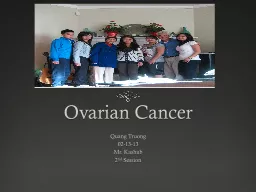

Quang Truong 021313 Mr Kashub 2 nd Session What is Ovarian Cancer Ovarian cancer is a cancerous growth arising from the ovary The silent killer What are the types of ovarian cancer you may have ID: 552045
Download Presentation The PPT/PDF document "Ovarian Cancer" is the property of its rightful owner. Permission is granted to download and print the materials on this web site for personal, non-commercial use only, and to display it on your personal computer provided you do not modify the materials and that you retain all copyright notices contained in the materials. By downloading content from our website, you accept the terms of this agreement.
Slide1
Ovarian Cancer
Quang Truong02-13-13Mr. Kashub 2nd SessionSlide2
What is Ovarian Cancer?Ovarian cancer is a cancerous growth arising from the ovary.The “silent killer” Slide3
What are the types of ovarian cancer you may have?There are more than 30 different types of ovarian cancer which are classified according to the type of cell from which they start. Cancerous ovarian tumors can start from three common cell types:Surface Epithelium - cells covering the lining of the ovariesGerm Cells - cells that are destined to form eggsStromal Cells - Cells that release hormones and connect the different structures of the ovariesSlide4
What is the cause for ovarian cancer?The precise cause of ovarian cancer is unknown, but several risk and contributing factors (including both reproductive and genetic factors) have been identified.Slide5
What are the stages for ovarian cancer?Stage I - Growth of the cancer is limited to the ovary or ovaries. Stage II - Growth of the cancer involves one or both ovaries with pelvic extension. Stage III - Growth of the cancer involves one or both ovaries, and one or both of the following are present: (1) the cancer has spread beyond the pelvis to the lining of the abdomen; and (2) the cancer has spread to lymph nodes. The tumor is limited to the true pelvis but with histologically proven malignant extension to the small bowel or
omentum.Stage IV - This is the most advanced stage of ovarian cancer. Growth of the cancer involves one or both ovaries and distant metastases (spread of the cancer to organs located outside of the peritoneal cavity) have occurred. Finding ovarian cancer cells in pleural fluid (from the cavity which surrounds the lungs) is also evidence of stage IV disease.Slide6
How to lower my risk ovarian cancer?Changing lifestyle or eating habits.Avoiding things known to cause cancer.Check ups from doctors. Ex: Pelvic ExamTaking medicines to treat a precancerous condition or to keep cancer from starting. Slide7
What are the symptoms for ovarian cancer?Abdominal pressure, fullness, swelling or bloatingPelvic discomfort or painPersistent indigestion, gas or nauseaChanges in bowel habits, such as constipationChanges in bladder habits, including a frequent need to urinateLoss of appetite or quickly feeling fullIncreased abdominal girth or clothes fitting tighter around your waist
A persistent lack of energyLow back painSlide8
Does it hurt?In its earliest stages, ovarian cancer can cause no symptoms at all or only mild symptoms that may be attributed to another illness.Pain in the more advanced stages of ovarian cancer is common.Women can experience different types of pain due to ovarian cancer.To control the pain is either deal with it or pain medication.Slide9
What treatments needed for ovarian cancer? The treatment of ovarian cancer depends on the stage of the disease, the histologic cell type, and the patient's age and overall condition. There are basically three forms of treatment of ovarian cancer. Removal of the ovaries, chemotherapy to kill the cancer cells, and radiation treatment to kill the cancer sites. Slide10
What are they going to do to me?Bilateral salpingo-oophorectomy (BSO) procedureThe surgeon needs to make sure that as much cancer as possible has been removed. You will be in hospital for 3 to 5 days. And recovering at home afterwards for at least another month or so.Slide11
What happens after surgery?When you wake up after your operation you will have a few tubes in place.-A drip (intravenous infusion) into a vein in your arm to give you fluids until you are eating and drinking again-A tube (catheter) into your bladder to drain your urineSlide12
How you may feel after treatment?Surgery- Hormonal effects, FatigueChemo- Fatigue, N/V, Hair loss, DiarrheaRadiation- (Fatigue) Other side effects depend on the part of your body being treated.Slide13
What are some test to see if you have ovarian cancer?Pelvic ExaminationTransvaginal ultrasoundCA-125 assayBiopsy X-rayLower gastrointestinal (GI) seriesComputed tomography (CT or CAT) ScanPositron emission tomography (PET) ScanSlide14
How long can you live with ovarian cancer?Ovarian cancer that is caught early enough can be cured with surgery and you can live a normal life. Ovarian cancer that can't be cured can be treated repeatedly. Many women live for years with ovarian cancer with intermittent treatment, but each case is different. Most ovarian cancers are already stage 3 or 4 when they are diagnosed so we really don't know how long it took them to get there. In retrospect, many women have had symptoms for many months before their diagnosis. There may also be an asymptomatic stage that could last for months or even years before the symptoms begin.Slide15
My chances of SurvivingSlide16
What is the best doctor for ovarian cancer?A gynecologic oncologist is a doctor who specializes in using surgery to treat cancer in a woman’s reproductive organs. Slide17
Why I Choose this and what’s need to be change?Grandma #8Change of lifestyle, culture/beliefs, & understanding. Slide18
Resourceshttp://www.mayoclinic.com/health/ovarian-cancer/DS00293/DSECTION=symptomshttp://ovariancancer.jhmi.edu/treatment.cfmhttp://www.cancerresearchuk.org/cancer-help/type/ovarian-cancer/treatment/surgery-for-ovarian-cancer
http://www.cancer.gov/cancertopics/pdq/prevention/ovarian/Patient/page1http://www.cancer.org/cancer/ovariancancer/overviewguide/ovarian-cancer-overview-survivalhttp://www.ovarian.org/types_and_stages.php